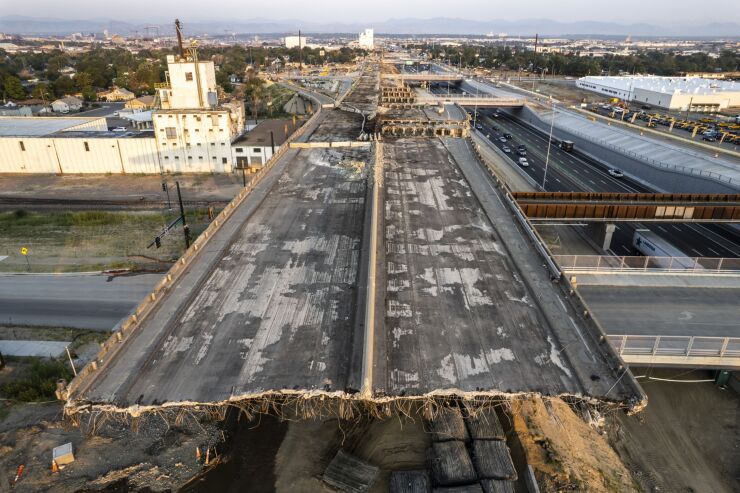While the Biden administration and Congress hash out plans for national infrastructure spending, shrinking borrowing costs across sectors and credit quality offer an opportunity that state and local governments shouldn’t waste, Merritt Research Services says in a new report.
It’s no secret that interest rates have held steady at historical lows despite some COVID-19 pandemic related bumps but a confluence of factors from borrowing rates and credit spread compression to issuers’ penchant for refundings over new money could be leveraged to fund new investments now.
“Aggregate outstanding borrowing rates have fallen in all credit sectors and at all quality levels, creating an ideal time to issue new debt,” said Richard Ciccarone, president of Merritt Research Services, an Investortools Company.

“The outstanding median cost of carry in a single year is lower by near 1% for many credit sectors over the past decade. That’s a big savings, if applied to offset the cost of capital improvements,” he said.
“Regardless of what happens in Washington, now is the time to take advantage of the window of opportunity to match long-term borrowing with infrastructure reinvestment,” Ciccarone said, adding that economic swings could soon eliminate that opportunity.
“Issuers must act now before higher rates and inflation return,” he said.
Merritt compiled financial data from 10,000 municipal borrowers that assesses a municipal bond credit’s relative interest cost burden by sector type to establish an “aggregate outstanding borrowing rate.” The new metric is designed to provide a quantifiable net effect of lower outstanding debt costs by comparing the interest expense to total debt outstanding. It looks at individual credits over their own five- to 10-year trend.
The data — which could see some adjustment as fresh 2020 audits are released — provided evidence that all major sectors are seeing historic lows. The report looked at general obligation issuance and revenue bonds separately.
Since 2010, the median aggregate outstanding borrowing cost of the general obligation group, which includes states, cities, counties, and school districts, fell by 1% to 3.38% from 4.48% which amounts to about $1 million in savings for a single year on outstanding debt levels of $100 million.
“Those savings can be leveraged and applied to a new 30-year bond issue to address a wider base of necessary infrastructure improvements” without the need to further burden taxpayers, Ciccarone wrote. “The impact is real, and the corresponding savings reinforce the idea that now is the time to proceed with increasingly essential capital plan improvements.”
State rates were down to a collective 3.41% in 2020 from 4.21% a decade earlier while cities were down to 3.26% from 4.34% and schools fell to 3.44% from 4.43%.
The squeeze has let up on even those states with the largest debt loads, although Illinois and some others buck the trend.
Illinois which has not yet released its last fiscal year audit had the highest aggregate outstanding among states in 2019 at 5.54%, up from 4.26% in 2010. “Illinois’ substantial use of taxable bond financings, the higher interest costs it pays on its backlog of bills, and its lack of state tax-exemptions, all contributed to a higher interest expense ratio,” the report said.
Municipal revenue bonds issued by public enterprises, special purpose entities, and other authorities — including hospitals, private universities, and not-for-profit tax-exempt entities — all saw declines in interest costs to debt totals since 2010 dropping collectively to 3.58% from 4.33%
Airports and hospitals experienced the greatest benefit, with their sectors’ interest expense ratios dropping 1.2 % and 1%, respectively, to 3.68% and 3.52%, respectively.
While aggregate outstanding borrowing rates may have fallen, borrowers also deleveraged, letting matured bonds roll off their balance sheets. Total sector debt loads have fallen over the past three years and all municipal bond sectors and through 2017, with retired debt exceeding new bond issues.
At the same time, tax-exempt issuers have enjoyed one of the longest stretches of low-cost borrowing in history.
In seven of the last eleven years, the benchmark Refinitiv MMD AAA 30-year tax-exempt municipal bond averaged a daily yield of less than 3%. On July 23, the benchmark stood at 1.36%, well below the 2010 average daily yield of 4.25%. These levels contrast favorably to annual long-term tax-exempt rates averaging more than 4% since 1968.

Borrowers took advantage on the refunding front “rather than commence a frontal assault on America’s aging capital stock,” the report said. New money did hit $275 billion in 2020 nearing the 2010 peak of $280 billion but it incorporated deficit borrowing to deal with COVID-related fiscal deficits.
Meanwhile average age of governmental property, plant, and equipment is growing with cities in most need of attention as their average age of the capital plant ratio has risen steadily to 16.2 years in 2019 from 12.9 years in 2010.
Political resistance often drives reluctance but that just adds to future costs when restoration becomes critical, but the low rates and drop in debt loads “in turn, creates some budgetary breathing room for infrastructure improvements without increasing the burden on taxpayers, ratepayers, and other stakeholders,” the report said.
Adding to the benefits is that “low rates, stabilized credit quality, and a strong appetite for bonds across much of the municipal spectrum have narrowed the yield difference between higher and lower quality borrowers,” the report said.
On the national front an infrastructure deal
The various factions did not disclose details of the agreement.
The $579 billion bipartisan infrastructure framework,
Democrats plan to push through additional “human infrastructure” spending in a $3.5 trillion package opposed by the GOP. That package would be taken up through the budget reconciliation process that simply requires a simple majority and wouldn’t allow a filibuster to block a vote.
House Speaker Nancy Pelosi, D-Calif., over the weekend said the House would not vote on the infrastructure package until the budget bill passes the Senate.





